Abstract
Purpose
The study was to survey personal hygiene practice related to genito-urinary tract and menstrual hygiene management in female adolescents in order to obtain basic information for health education.
Methods
With a descriptive survey design, 389 adolescents were recruited via convenience sampling in Korea. Survey instrument was the feminine and menstrual hygiene practice and perception of vaginal douching. Data were collected from a self-administered structured questionnaire.
Results
Mean age of adolescents was 16.09 and menarche was at 13.21. While washing hands after urination/defecation was highly performed, wipe front to back and wash with soap and water were reported as being not well done. Twenty-eight percent reported douching habit. More positive beliefs about douching were reported by adolescents who practiced douching. Menstrual hygiene management was very appropriate with changing sanitary pads regularly with hand washing; but less performed for limiting bathing activity during menstrual periods and washing hands after activity of genito-urinary area.
Conclusion
Some adolescents practiced inadequate hygiene practices especially for body cleansing during menstrual period and vaginal douching. It is important to develop and implement school health education programs on feminine and personal hygiene for adolescents to help them perform adequate health behaviors.
Figures and Tables
Summary Statement
▪ What is already known about this topic?
Studies on feminine hygiene practice have been conducted with adolescents, young and middle-aged women. Inadequate feminine and personal hygiene was related to various genito-urinary infection and reproductive health problems. There was a paucity of studies conducted in Korea.
▪ What this paper adds?
Levels of personal hygiene practice regarding genito-urinary tract and menstrual hygiene management were high. However, wiping front to back, washing with soap and water, and bodily cleansing during menstrual period were not well performed. Some adolescents had wrong perceptions of vaginal douching and practiced this method which was inadequate feminine and personal hygiene practice.
▪ Implications for practice, education and/or policy
School health education about proper feminine and personal hygiene practices is recommended for adolescents to obtain adequate health behaviors for future reproductive health.
References
1. Czerwinski BS. Variation in feminine hygiene practices as a function of age. J Obstet Gynecol Neonatal Nurs. 2000; 29(6):625–633.

2. Korea Center for Disease Control and Prevention. The Statistics of 9th Korea Youth Risk Behavior Web-based Survey (KYRBWS) in 2013. Seoul: Author;2013. p. 436.
3. Blythe MJ, Fortenberry JD, Orr DP. Douching behaviors reported by adolescent and young adult women at high risk for sexually transmitted infections. J Pediatr Adolesc Gynecol. 2003; 16(2):95–100.

4. Annang L, Grimley DM, Hook EW 3rd. Vaginal douche practices among black women at risk: Exploring douching prevalence, reasons for douching, and sexually transmitted disease infection. Sex Transm Dis. 2006; 33(4):215–219.

5. Kokotos F. Vulvovaginits. Pediatr Rev. 2006; 27(3):116–117.
6. Schwebke JR, Desmond RA, Oh MK. Predictors of bacterial vaginosis in adolescent women who douche. Sex Transm Dis. 2004; 31(7):433–436.

7. Dasgupta A, Sarkar M. Menstrual hygiene: How hygienic is the adolescent girl? Indian J Community Med. 2008; 33(2):77–80.

8. El-Gilany AH, Badawi K, El-Fedawy S. Menstrual hygiene among adolescent schoolgirls in Mansoura, Egypt. Reprod Health Matters. 2005; 13(26):147–152.

9. Ali TS, Sami N, Khuwaja AK. Are unhygienic practices during the menstrual., partum and postpartum periods risk factors for secondary infertility? J Health Popul Nutr. 2007; 25(2):189–194.
10. Adams Hillard PJ. Menstruation in young girls: A clinical perspective. Obstet Gynecol. 2002; 99(4):655–662.

11. Poureslami M, Osati-Ashtiani F. Assessing knowledge, attitudes, and behavior of adolescent girls in suburban districts of Tehran about dysmenorrhea and menstrual hygiene. J Int Womens Stud. 2002; 3(2):51–61.
12. Cottrell BH. An updated review of evidence to discourage douching. MCN Am J Matern Child Nurs. 2010; 35(2):102–107.
13. Low N, Chersich MF, Schmidlin K, Egger M, Francis SC, vad de Wijgert JH, et al. Intravaginal practices, bacterial vaginosis, and HIV infection in women: Individual participant data metaanalysis. PLoS Med. 2011; 8(2):e1000416.

14. Foch BJ, McDaniel ND, Chacko MR. Racial differences in vaginal douching knowledge, attitude, and practices among sexually active adolescents. J Pediatr Adolesc Gynecol. 2001; 14(1):29–33.

15. Funkhouser E, Hayes TD, Vermund SH. Vaginal douching practices among women attending a university in the Southern United States. J Am Coll Health. 2002; 50(4):177–182.

16. Cottrell BH, Close FT. Vaginal douching among university women in the southeastern United States. J Am Coll Health. 2008; 56(4):415–421.

17. McKee MD, Baquero M, Fletcher J. Vaginal hygiene practices and perceptions among women in the urban Northeast. Women Health. 2009; 49(4):321–333.

18. Ahn S. Feminine hygiene and vaginal douche practices in middle-aged women. Korean J Women Health Nurs. 2013; 19(4):285–294.

19. Ogino M, Iino K, Minoura S. Habitual use of warm-water cleaning toilets is related to the aggravation of vaginal microflora. J Obstet Gynaecol Res. 2010; 36(5):1071–1074.

20. Diclemente RJ, Young AM, Painter JL, Wingood GM, Rose E, Sales JM. Prevalence and correlates of recent vaginal douching among African American adolescent females. J Pediatr Adolesc Gynecol. 2012; 25(1):48–53.

21. Short MB, Black WR, Flynn K. Discussions of vaginal douching with family members. J Pediatr Adolesc Gynecol. 2010; 23(1):39–44.

22. Mehta S, Khatuja R, Nigam S, Gupta K, Goel N. Menstrual hygiene: A 'red alert' situation. Eur J Obstet Gynecol Reprod Biol. 2013; 170(2):577–578.

23. Sommer M, Sahin M. Overcoming the taboo: Advancing the global agenda for menstrual hygiene management for schoolgirls. Am J Public Health. 2013; 103(9):1556–1559.

24. Centers for Disease control and prevention. Key Statistics from the National Survey of Family Growth [Internet]. Atlanta: Author;2013. cited 2013 September 3. Available from: http://www.cdc.gov/nchs/nsfg/key_statistics/d.htm#douching.




 PDF
PDF ePub
ePub Citation
Citation Print
Print






 XML Download
XML Download